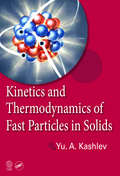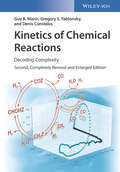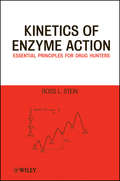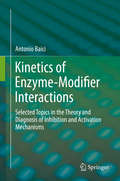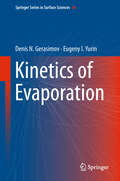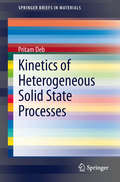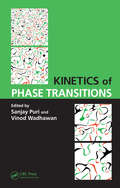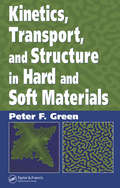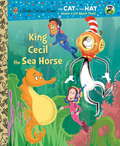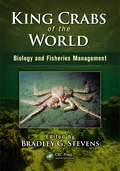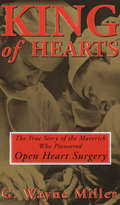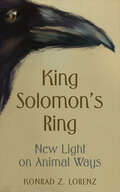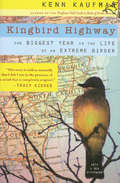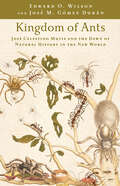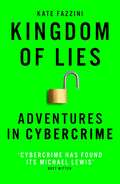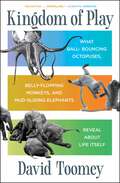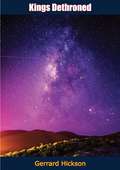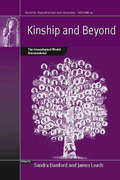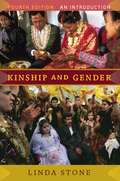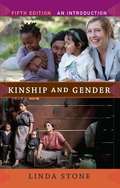- Table View
- List View
Kinetics and Thermodynamics of Fast Particles in Solids
by Yurii KashlevKinetics and Thermodynamics of Fast Particles in Solids examines the kinetics and non-equilibrium statistical thermodynamics of fast charged particles moving in crystals in different modes. It follows a line of research very different from traditional ways of constructing a theory of radiation effects, which gives a purely mechanistic interpretatio
Kinetics in Materials Science and Engineering
by Dennis W. Readey"A pedagogical gem…. Professor Readey replaces ‘black-box’ explanations with detailed, insightful derivations. A wealth of practical application examples and exercise problems complement the exhaustive coverage of kinetics for all material classes." –Prof. Rainer Hebert, University of Connecticut "Prof. Readey gives a grand tour of the kinetics of materials suitable for experimentalists and modellers…. In an easy-to-read and entertaining style, this book leads the reader to fundamental, model-based?understanding of kinetic processes critical to development, fabrication and application of commercially-important soft (polymers, biomaterials), hard (ceramics, metals) and composite materials. It is a must-have for anyone who really wants to understand how to make materials and how they will behave in service." --Prof. Bill Lee, Imperial College London, Fellow of the Royal?Academy of Engineering "A much needed text filing the gap between an introductory course in materials science and advanced materials-specific kinetics courses. Ideal for the undergraduate interested in an in-depth study of kinetics in materials." –Prof. Mark E. Eberhart, Colorado School of Mines This book provides an in-depth introduction to the most important kinetic concepts in materials science, engineering, and processing. All types of materials are addressed, including metals, ceramics, polymers, electronic materials, biomaterials, and composites. The expert author with decades of teaching and practical experience gives a lively and accessible overview, explaining the principles that determine how long it takes to change material properties and make new and better materials. The chapters cover a broad range of topics extending from the heat treatment of steels, the processing of silicon integrated microchips, and the production of cement, to the movement of drugs through the human body. The author explicitly avoids "black box" equations, providing derivations with clear explanations.
Kinetics of Chemical Reactions: Decoding Complexity
by Guy B. Marin Gregory S. Yablonsky Denis ConstalesThis second, extended and updated edition presents the current state of kinetics of chemical reactions, combining basic knowledge with results recently obtained at the frontier of science. Special attention is paid to the problem of the chemical reaction complexity with theoretical and methodological concepts illustrated throughout by numerous examples taken from heterogeneous catalysis combustion and enzyme processes. Of great interest to graduate students in both chemistry and chemical engineering.
Kinetics of Complex Plasmas
by Mahendra Singh SodhaThe presentation in the book is based on charge balance on the dust particles, number and energy balance of the constituents and atom-ion-electron interaction in the gaseous plasma. Size distribution of dust particles, statistical mechanics, Quantum effects in electron emission from and accretion on dust particles and nonlinear interaction of complex plasmas with electric and electromagnetic fields have been discussed in the book. The book introduces the reader to basic concepts and typical applications. The book should be of use to researchers, engineers and graduate students.
Kinetics of Enzyme Action
by Ross L. SteinFew scientists have the knowledge to perform the studies that are necessary to discover and characterize enzyme inhibitors, despite the vested interest the pharmaceutical industry has in this field. Beginning with the most basic principles pertaining to simple, one-substrate enzyme reactions and their inhibitors, and progressing to a thorough treatment of two-substrate enzymes, Kinetics of Enzyme Action: Essential Principles for Drug Hunters provides biochemists, medicinal chemists, and pharmaceutical scientists with numerous case study examples to outline the tools and techniques necessary to perform, understand, and interpret detailed kinetic studies for drug discovery.
Kinetics of Enzyme-Modifier Interactions
by Antonio BaiciThe kinetic mechanisms by which enzymes interact with inhibitors and activators, collectively called modifiers, are scrutinized and ranked taxonomically into autonomous species in a way similar to that used in the biological classification of plants and animals. The systematization of the mechanisms is based on two fundamental characters: the allosteric linkage between substrate and modifier and the factor by which a modifier affects the catalytic constant of the enzyme. Combinations of the physically significant states of these two characters in an ancestor-descendant-like fashion reveal the existence of seventeen modes of interaction that cover the needs of total, partial and fine-tuning modulation of enzyme activity. These interactions comprise five linear and five hyperbolic inhibition mechanisms, five nonessential activation mechanisms and two hybrid species that manifest either hyperbolic inhibition or nonessential activation characteristics depending on substrate concentration. Five essential activation mechanisms, which are taxonomically independent of the mentioned basic species, complete the inventory of enzyme modifiers. Often masked under conventional umbrella terms or treated as anomalous cases, all seventeen basic inhibition and nonessential activation mechanisms are represented in the biochemical and pharmacological literature of this and the past century, either in the form of rapid or slow-onset reversible interactions, or as irreversible modification processes. The full potential of enzyme inhibitors and activators can only be appreciated after elucidating the details of their kinetic mechanisms of action exploring the entire range of physiologically significant reactant concentrations. This book highlights the wide spectrum of allosteric enzyme modification in physiological occurrences as well as in pharmacological and biotechnological applications that embrace simple and multiple enzyme-modifier interactions. The reader is guided in the journey through this still partly uncharted territory with the aid of mechanistically-oriented criteria aimed at showing the logical way towards the identification of a particular mechanism.
Kinetics of Evaporation (Springer Series in Surface Sciences #68)
by Denis N. Gerasimov Eugeny I. YurinThis monograph discusses the essential principles of the evaporationprocess by looking at it at the molecular and atomic level.In the first part methods of statistical physics, physical kinetics andnumerical modeling are outlined including the Maxwell’s distributionfunction, the Boltzmann kinetic equation, the Vlasov approach, and theCUDA technique.The distribution functions of evaporating particles are then defined.Experimental results on the evaporation coefficient and the temperaturejump on the evaporation surface are critically reviewed and compared tothe theory and numerical results presented in previous chapters.The book ends with a chapter devoted to evaporation in differentprocesses, such as boiling and cavitation.This monograph addressesgraduate students and researchers working on phase transitions andrelated fields.
Kinetics of Heterogeneous Solid State Processes
by Pritam DebKinetic studies have traditionally being extremely useful in characterizing several physical and chemical phenomena in organic, inorganic and metallic systems. It provides valuable qualitative, quantitative and kinetic information on phase transformations, solid state precipitation, crystallization, oxidation and decomposition. Unfortunately, no single reference comprehensively presents nonisothermal kinetic analysis method for the study of complex processes, determining the actual mechanism and kinetic parameters. This book provides a new method for nonisothermal kinetics and its application in heterogeneous solid state processes. In the backdrop of limitations in existing methods, the book presents a brief review of the widely used isothermal and nonisothermal kinetic analysis methods.
Kinetics of Metallurgical Processes (Indian Institute Of Metals Ser.)
by Hem Shanker Ray Saradindukumar RayThis book is intended as a text for upper undergraduate and graduate courses on kinetics of metallurgical processes for students of materials science, metallurgical engineering, and chemical engineering. Focusing on basic and essential topics, selected from the authors’ teaching and research, it serves as a comprehensive guide to metallurgical kinetics. Chapters 1–10 discuss the “logic” of various kinetics processes, while Chapter 11 explores the systematic analysis of raw rate data generated from controlled experiments. The final chapters illustrate how the fundamental concept of thermal activation is used to describe the kinetics of rate-dependent plastic deformation and creep fracture. With numerous examples, illustrations, and step-by-step tutorials, it is ideally suited for both self-study and classroom use. The examples were selected from research papers to highlight how the topics discussed can be, and are, used to solve real-world technological problems. Providing a comprehensive list of resources for further study, and end-of-chapter review questions to help students test their knowledge, it can be used for university coursework or as a text for professional development courses.
Kinetics of Phase Transitions
by Sanjay Puri Vinod WadhawanProviding a comprehensive introduction with the necessary background material to make it accessible for a wide scientific audience, Kinetics of Phase Transitions discusses developments in domain-growth kinetics. This book combines pedagogical chapters from leading experts in this area and focuses on incorporating various experimentally releva
Kinetics, Transport, and Structure in Hard and Soft Materials
by Peter F. GreenKinetics, Transport, and Structure in Hard and Soft Materials is the only single reference that discusses the connection between structure and mechanisms of atomic or molecular transport in different classes of materials, from metals and semiconductors to network glasses, polymers and supercooled liquids.Divided into four parts, Part
King Cecil the Sea Horse (Little Golden Book)
by Tish Rabe Christopher MoroneyWhen Sally and Nick need to learn about babysitting, the Cat in the Hat takes them to meet an expert: King Cecil the Seahorse! That's because when it comes to having babies, seahorses give birth in a very special way. The mom seahorse puts her eggs into a pouch on the dad, and he carries them there until the babies hatch (in his pouch) and swim out! Perfect for summer reading, nights with the babysitter, Father's Day--any day, really. This Little Golden Book based on an episode of the hit PBS Kids' TV show The Cat in the Hat Know a Lot About That! will keep kids laughing, teach them about a very unique animal, and even inspire conversations about gender roles!
King Crabs of the World: Biology and Fisheries Management
by Bradley G. StevensWith species existing in all subpolar seas, king crabs are one of the most valuable seafoods. Major fluctuations in their abundance have stimulated a flurry of research and a rapid expansion of the scientific literature in the last decade. King Crabs of the World: Biology and Fisheries Management consolidates extensive knowledge on the biology, sys
King Of Hearts: The True Story of the Maverick Who Pioneered Open Heart Surgery
by G. Wayne MillerFew of the great stories of medicine are as palpably dramatic as the invention of open-heart surgery, yet, until now, no journalist has ever brought all of the thrilling specifics of this triumph to life. This is the story of the surgeon many call the father of open-heart surgery, Dr. C. Walton Lillehei, who, along with colleagues at University Hospital in Minneapolis and a small band of pioneers elsewhere, accomplished what many experts considered to be an impossible feat: He opened the heart, repaired fatal defects, and made the miraculous routine. Acclaimed author G. Wayne Miller draws on archival research and exclusive interviews with Lillehei and legendary pioneers such as Michael DeBakey and Christiaan Barnard, taking readers into the lives of these doctors and their patients as they progress toward their landmark achievement. In the tradition of works by Richard Rhodes and Tracy Kidder,King of Heartstells the story of an important and gripping piece of forgotten science history. From the Hardcover edition.
King Solomon's Ring: New Light on Animal Ways
by Konrad Z. LorenzLike Solomon with his magic ring, famed Austrian ethologist Konrad Lorenz was a gifted student of the animal world. King Solomon's Ring, the book which brought him worldwide recognition, is a delightful collection of observations and insights into the lives of our furry and feathered friends, from the familiar cats and dogs to jackdaws. A must read for any animal lover.
Kingbird Highway: The Biggest Year in the Life of an Extreme Birder
by Kenn KaufmanAn ornithologist&’s account of his youthful, year-long, cross-country birdwatching adventure: &“A fascinating memoir of an obsession.&” —Booklist At sixteen, Kenn Kaufman dropped out of the high school where he was student council president and hit the road, hitching back and forth across America, from Alaska to Florida, Maine to Mexico. Maybe not all that unusual a thing to do in the seventies, but what Kenn was searching for was a little different: not sex, drugs, God, or even self, but birds. A report of a rare bird would send him hitching nonstop from Pacific to Atlantic and back again. When he was broke he would pick fruit or do odd jobs to earn the fifty dollars or so that would last him for weeks. His goal was to set a record—most North American species seen in a year—but along the way he began to realize that at this breakneck pace he was only looking, not seeing. What had been a game became a quest for a deeper understanding of the natural world. Kingbird Highway is a unique coming-of-age story, combining a lyrical celebration of nature with wild, and sometimes dangerous, adventures, starring a colorful cast of characters.
Kingdom of Ants: José Celestino Mutis and the Dawn of Natural History in the New World
by Edward O. Wilson José M. DuránOne of the earliest New World naturalists, José Celestino Mutis began his professional life as a physician in Spain and ended it as a scientist and natural philosopher in modern-day Colombia. Drawing on new translations of Mutis's nearly forgotten writings, this fascinating story of scientific adventure in eighteenth-century South America retrieves Mutis's contributions from obscurity.In 1760, the 28-year-old Mutis—newly appointed as the personal physician of the Viceroy of the New Kingdom of Granada—embarked on a 48-year exploration of the natural world of northern South America. His thirst for knowledge led Mutis to study the region's flora, become a professor of mathematics, construct the first astronomical observatory in the Western Hemisphere, and amass one of the largest scientific libraries in the world. He translated Newton's writings and penned essays about Copernicus; lectured extensively on astronomy, geography, and meteorology; and eventually became a priest. But, as two-time Pulitzer Prize–winner Edward O. Wilson and Spanish natural history scholar José M. Gómez Durán reveal in this enjoyable and illustrative account, one of Mutis's most magnificent accomplishments involved ants. Acting at the urging of Carl Linnaeus—the father of taxonomy—shortly after he arrived in the New Kingdom of Granada, Mutis began studying the ants that swarmed everywhere. Though he lacked any entomological training, Mutis built his own classification for the species he found and named at a time when New World entomology was largely nonexistent. His unorthodox catalog of army ants, leafcutters, and other six-legged creatures found along the banks of the Magdalena provided a starting point for future study.Wilson and Durán weave a compelling, fast-paced story of ants on the march and the eighteenth-century scientist who followed them. A unique glance into the early world of science exploration, Kingdom of Ants is a delight to read and filled with intriguing information.
Kingdom of Lies: Unnerving adventures in the world of cybercrime
by Kate FazziniWould you say your phone is safe, or your computer? What about your car? Or your bank? There is a global war going on and the next target could be anyone – an international corporation or a randomly selected individual. From cybercrime villages in Romania to intellectual property theft campaigns in China, these are the true stories of the hackers behind some of the largest cyberattacks in history and those committed to stopping them. You&’ve never heard of them and you&’re not getting their real names. Kate Fazzini has met the hackers who create new cyberweapons, hack sports cars and develop ransomware capable of stopping international banks in their tracks. Kingdom of Lies is a fast-paced look at technological innovations that were mere fantasy only a few years ago, but now make up an integral part of all our lives.
Kingdom of Play: What Ball-bouncing Octopuses, Belly-flopping Monkeys, and Mud-sliding Elephants Reveal about Life Itself
by David ToomeyThis &“delightful…compelling&” (Scientific American) and revelatory look at the science behind why animals play &“will fill you with joy and wonder&” (Sy Montgomery, author of The Soul of an Octopus).Acclaimed science writer David Toomey takes us on a fast-paced and entertaining tour of playful animals and the scientists who study them. From octopuses on Australia&’s Great Barrier Reef to meerkats in the Kalahari Desert to brown bears on Alaska&’s Aleutian Islands, we follow adventurous researchers as they design and conduct experiments seeking answers to new, intriguing questions: When did play first appear in animals? How does play develop the brain, and how did it evolve? Are the songs and aerial acrobatics of birds the beginning of avian culture? Is fairness in dog play the foundation of canine ethics? And does play direct and possibly accelerate evolution? Monkeys belly flop, dolphins tail-walk, elephants mud-slide, crows dive-bomb, and octopuses bounce balls. These activities are various, but all are play, and as Toomey explains, animal play can be defined as a distinct behavior that is ongoing and open-ended, purposeless and provisional—rather like natural selection. Through a close examination of both natural selection and play, Toomey argues that life itself is fundamentally playful. A &“lively, informative, and scientifically entertaining animal behavior study&” (Kirkus Reviews) Kingdom of Play is an illuminating—and yes, playful—look at a little-known aspect of the animal kingdom.
Kingdom of the Sun
by Jacqueline MittonChildren take a wondrous tour of our solar system in this stunning new book that weaves mythology and astronomy in magical ways. Jacqueline Mitton's poetic text explores each planet, comparing its features to those of the Roman god or goddess for whom it was named. Although this naming occurred long before humans had accurate information about the planets, the book points out some remarkable coincidences based on what we know today. The veiled goddess Venus, for example, lends her name to a cloud-veiled planet. And the blue, stormy planet Neptune is named for the god of the sea. This intriguing and highly informative book--a sequel to the same team's best-selling Zoo in the Sky--presents the most up-to-date, scientific details about the planets in an artful way that will stir the minds and imaginations of young readers.
Kings Dethroned: A History Of The Evolution Of Astronomy From The Time Of The Roman Empire Up To The Present Day; Showing It To Be An Amazing Series
by Gerrard HicksonAt the turn of the twentieth century, Gerrard Hickson stumbled upon a discovery which convinced him of something shocking. The giants of astronomy had miscalculated the distance of the sun from the Earth, it was closer than we ever thought. The popular estimate of approximately ninety-three million miles appeared to be a mistake, as inconceivable as it seemed.Hickson pored through the methods that his predecessors had used to calculate the distance and the accounts of their work, searching for the means to disprove his theory but instead he found a mistake in Dr. Hailey’s diurnal method. Invented by Hailey in the nineteenth century and used as a basis for many other calculations about our solar system.We can only imagine that Hickson must have gritted his teeth when he set himself the challenge of proving Dr. Hailey’s error. Kings Dethroned is the result of his research, and through his retracing of the steps of astronomers from the Roman Empire all the way up to the present day, we can see an accurate representation of the planets and our sun.Gerrard Hickson, unlike his predecessors, took his findings to the general public and published this book for the consumption of all. Having been rejected or ignored by experts and scientific societies across the western world, he chose to trust in the public. He felt that the truth and his discovery were the wealth of the whole human species and in this modern age it does the reader only good to contemplate the necessity of constant and honest scientific enquiry.
Kinomics
by Sanela Martic Heinz-Bernhard KraatzAuthored by the world's leading kinase experts, this is a comprehensive introduction to current knowledge and practice within this emerging field. Following an overview of the major players and pathways that define the kinome, the major part of this work is devoted to current strategies of kinome investigation and manipulation. As such, kinase engineering, peptide substrate engineering, co-substrate design and kinase inhibitor design are discussed in detail, and their potential applications in kinome analysis and kinome-based pharmacotherapy are shown. The result is a toolbox for every kinase researcher: By addressing and comparing current approaches to the study of kinase action, both novice and established researchers will benefit from the practical knowledge contained in this invaluable reference.
Kinship And Beyond
by Sandra Bamford James LeachThe genealogical model has a long-standing history in Western thought. The contributors to this volume consider the ways in which assumptions about the genealogical model--in particular, ideas concerning sequence, essence, and transmission--structure other modes of practice and knowledge-making in domains well beyond what is normally labeled "kinship." The detailed ethnographic work and analysis included in this text explores how these assumptions have been built into our understandings of race, personhood, ethnicity, property relations, and the relationship between human beings and non-human species. The authors explore the influences of the genealogical model of kinship in wider social theory and examine anthropology's ability to provide a unique framework capable of bridging the "social" and "natural" sciences. In doing so, this volume brings fresh new perspectives to bear on contemporary theories concerning biotechnology and its effect upon social life.
Kinship and Gender, 4e
by Linda StoneDesigned for undergraduate courses in kinship, gender, or the two combined, Linda Stone's Kinship and Gender is the product of years of teaching. The topic of kinship comes alive when linked to gender issues; conversely, the cross-cultural study of gender benefits from a working knowledge of kinship. This essential book successfully merges these two disciplines, demonstrating their relevance to students' lives and enhancing students' understanding of other cultures. Fourteen case studies throughout the book illuminate the intricate connections between kinship and gender across a variety of cultural groups. The fourth edition features a new chapter that reveals how kinship structures and related gender roles underlie many current social problems around the world. Also new to this edition are two original case studies, discussion questions, and listings of useful websites to aid further research.
Kinship and Gender, 5e
by Linda StoneDoes kinship still matter in today's globalized, increasingly mobile world? Do family structures continue to influence the varied roles that men and women play in different cultures? Answering with a resounding "yes!", Linda Stone offers a lively introduction to and working knowledge of kinship. She firmly links these concepts to cross-cultural gender studies, illuminating the malleable nature of gender roles around the world and over time.Written to engage students, each chapter provides key terms and useful generalizations gleaned through cross-cultural research on the interplay of kinship and gender in both traditional societies and contemporary communities. Detailed case studies help students understand how such generalizations are experienced "in real life." Stone also considers the ramifications of current social problems and recent developments in reproductive technology as she demonstrates the relevance of kinship and gender to students' lives.The fully-revised 5th edition features discussion of cross-cultural examples complimented by expanded coverage of kinship and gender dynamics within the United States. Stone considers current evolutionary research on kinship and gender, and offers new case studies addressing international adoptions and polygynous marriage. An entirely new chapter explores the globalization of kinship in the 21st century. The result is a broad and captivating exploration of anthropological approaches to family and gender.
